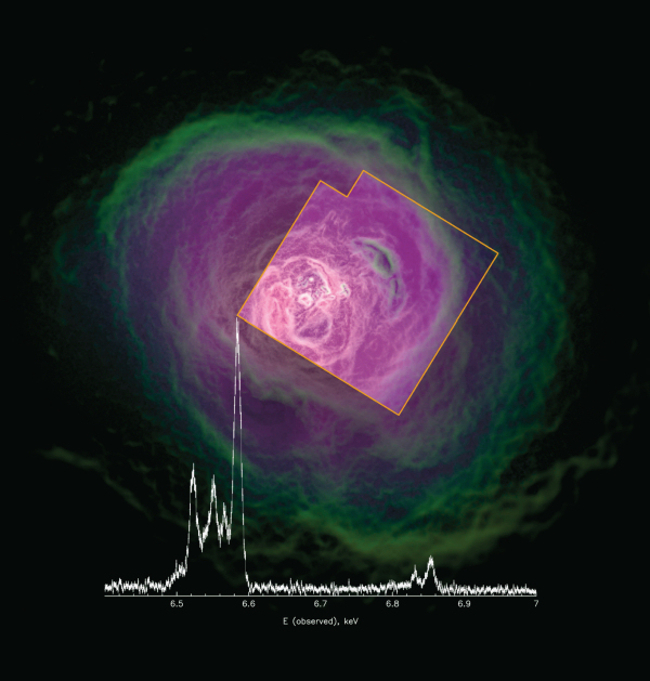
 Credit: Spectrum: Hitomi Collaboration/JAXA, NASA, ESA, SRON, CSA; Background: NASA/CXO
Credit: Spectrum: Hitomi Collaboration/JAXA, NASA, ESA, SRON, CSA; Background: NASA/CXO
A Map of Motion in Perseus
In 2016 astronomers released the first observed X-ray spectrum from the first operating X-ray calorimeter orbiting in space, the Soft X-ray Spectrometer (SXS) on the Hitomi observatory. X-ray calorimeters are revolutionary instruments that provide high-quality, high-resolution X-ray spectra over an extended area of the sky. They do this by measuring the infinitesimal change in the temperature of an absorbing material caused by absorbing the energy of an incident X-ray photon from a high-energy source in space. X-ray calorimeters are ideal for studying X-ray spectra from bright, extended X-ray sources like hot nebulae around stars, galaxies and clusters of galaxies, supernova remnants, and other objects. These observations provide a map of spatial differences in the X-ray spectrum, which can be used to understand the large-scale flow of the hot gas around the object. One of the first observations obtained by the SXS was of the Perseus Galaxy Cluster. Clusters of galaxies are the largest objects held together by their own gravity, with most of the normal matter contained in the hot, X-ray emitting gas that fills the space between the cluster galaxies. The graph in the image above is a sample of the X-ray spectrum of the Perseus Cluster obtained by the SXS, showing prominent, narrow emission lines from iron atoms in the intra-cluster gas. The field of view of the SXS is shown by the highlighted box superimposed on an X-ray image of the Perseus Cluster from the Chandra X-ray Observatory. The narrow emission lines in the SXS spectrum show that there is surprisingly little turbulence in the intra-cluster gas in the cluster. This was unexpected, since powerful jets produced from a supermassive black hole in one of the cluster galaxies was thought to stir up the intercluster gas to keep it heated to temperatures of millions of degrees. The next X-ray orbiting calorimeter will be the Resolve calorimeter, the prime instrument on the XRISM mission, scheduled for launch later this month.
Published: September 4, 2023
<
HEA Dictionary ● Archive
● Search HEAPOW
● Other Languages
● HEAPOW on Facebook
● Download all Images
● Education ● HEAD
>

Each week the HEASARC
brings you new, exciting and beautiful images from X-ray and Gamma ray
astronomy. Check back each week and be sure to check out the HEAPOW archive!
Page Author: Dr. Michael F. Corcoran
Last modified Tuesday, 27-Feb-2024 10:13:25 EST


